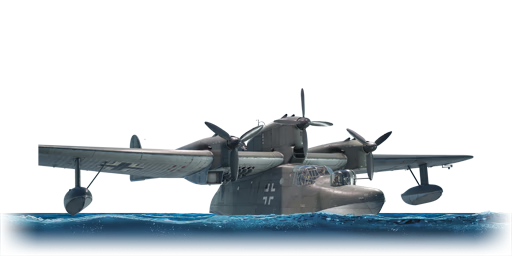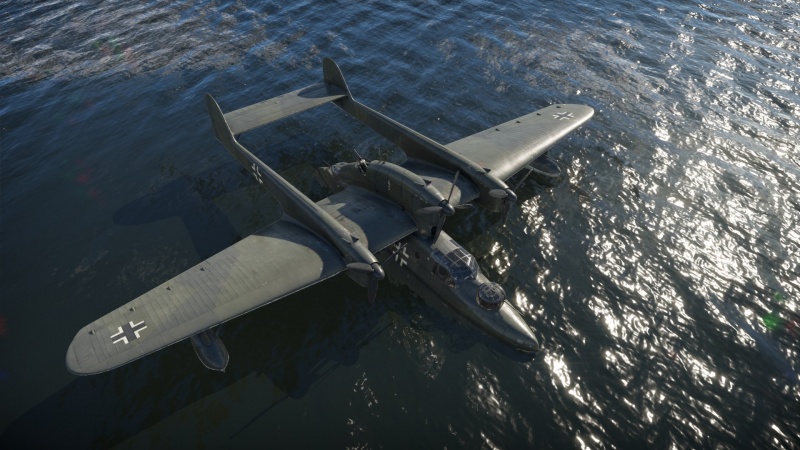Difference between revisions of "BV 138 C-1"
(Added stock performance stats. Edited the cons. Added features.) (Tag: Visual edit) |
Colok76286 (talk | contribs) (Edits) |
||
| Line 16: | Line 16: | ||
{| class="wikitable" style="text-align:center" width="70%" | {| class="wikitable" style="text-align:center" width="70%" | ||
! rowspan="2" | Characteristics | ! rowspan="2" | Characteristics | ||
| − | ! colspan="2" | Max Speed<br>(km/h at | + | ! colspan="2" | Max Speed<br>(km/h at sea level) |
! rowspan="2" | Max altitude<br>(metres) | ! rowspan="2" | Max altitude<br>(metres) | ||
! colspan="2" | Turn time<br>(seconds) | ! colspan="2" | Turn time<br>(seconds) | ||
| Line 114: | Line 114: | ||
* Small bomb load | * Small bomb load | ||
* Can't land on runways since it is a hydroplane | * Can't land on runways since it is a hydroplane | ||
| − | * Poor | + | * Poor climb rate |
== History == | == History == | ||
Revision as of 22:03, 11 September 2021
Contents
Description
The BV 138 C-1 is a rank I German bomber with a battle rating of 1.3 (AB) and 1.7 (RB/SB). It was introduced in Update "Direct Hit".
General info
Flight performance
Describe how the aircraft behaves in the air. Speed, manoeuvrability, acceleration and allowable loads - these are the most important characteristics of the vehicle.
| Characteristics | Max Speed (km/h at sea level) |
Max altitude (metres) |
Turn time (seconds) |
Rate of climb (metres/second) |
Take-off run (metres) | |||
|---|---|---|---|---|---|---|---|---|
| AB | RB | AB | RB | AB | RB | |||
| Stock | 266 | 253 | 41.0 | 44.2 | 0.6 | 0.6 | 700 | |
| Upgraded | ___ | ___ | __._ | __._ | __._ | __._ | ||
Details
| Features | ||||
|---|---|---|---|---|
| Combat flaps | Take-off flaps | Landing flaps | Air brakes | Arrestor gear |
| ✓ | ✓ | ✓ | X | X |
| Limits | ||||||
|---|---|---|---|---|---|---|
| Wings (km/h) | Gear (km/h) | Flaps (km/h) | Max Static G | |||
| Combat | Take-off | Landing | + | - | ||
| 0 | 450 | ___ | ___ | ___ | ~__ | ~__ |
| Optimal velocities (km/h) | |||
|---|---|---|---|
| Ailerons | Rudder | Elevators | Radiator |
| < ___ | < ___ | < ___ | > ___ |
Survivability and armour
Examine the survivability of the aircraft. Note how vulnerable the structure is and how secure the pilot is, whether the fuel tanks are armoured, etc. Describe the armour, if there is any, and also mention the vulnerability of other critical aircraft systems.
Modifications and economy
Armaments
Suspended armament
The BV 138 C-1 can be outfitted with the following ordnance:
- 6 x 50 kg SC50JA bombs (300 kg total)
Defensive armament
The BV 138 C-1 is defended by:
- 1 x 20 mm MG 151 cannon, nose turret (1,000 rpg)
- 1 x 20 mm MG 151 cannon, tail turret (900 rpg)
- 1 x 13 mm MG 131 machine gun, dorsal turret (1,450 rpg)
Usage in battles
Describe the tactics of playing in the aircraft, the features of using aircraft in a team and advice on tactics. Refrain from creating a "guide" - do not impose a single point of view, but instead, give the reader food for thought. Examine the most dangerous enemies and give recommendations on fighting them. If necessary, note the specifics of the game in different modes (AB, RB, SB).
Pros and cons
Pros:
- Excellent defensive armament
- Spare engine
Cons:
- Small bomb load
- Can't land on runways since it is a hydroplane
- Poor climb rate
History
Not immediately obvious, the BV 138 is one of the more unique vehicles in game: a twin boom fuselage is very rare for a seaplane design, the Sikorsky S-38 the closest analogue and possibly inspiration for this one. The little known but brilliant aircraft designer Dr Richard Vogt was hired away from Kawasaki Aircraft in Japan to join the Hamburger Flugzeugbau (HFB), bringing with him some highly innovative aircraft technologies. One of his first projects was the Ha 138, a twin-engine seaplane with gull wing similar to the PBM or the Be-6 but with twin booms to the tail plane, all to keep them high above the water. Unfortunately, the also highly innovative Jumo 205 diesel engines were underperforming so a third engine was mounted on the fuselage as an expedient modification. The first Ha 138 (V1) was, well, a failure. The fact it did not crash in tests was a minor miracle. The next one (V2) redesigned to be a straight wing with integrated middle engine was not much better, but the lessons from these early experiments were learned and V3 was scrapped half started.
With the company now called "Abteilung Flugzeugbau der Schiffswerft Blohm & Voss", "Blohm & Voss" for short, the manufacturer prefix was changed from "Ha" to "BV" (the only all capital letter Reichsluftfahrtministerium code) and the completely redesigned BV 138A-0 (V4) was built. All the shortcomings from the first two designs were eliminated and the Reichsluftfahrtministerium (RLM) and the Luftwaffe (LW) was happy with the design and ordered it into production. There were still shortcomings with the underpowered engine, so to compensate mounting points for the HWK 109-500 booster rockets where added.
The original 138 was well armed aircraft for the period, sporting an early 20 mm cannon in the nose turret, very likely to attack boats and ships. Interestingly the bomb racks were added much later in the B version. It was literally a rack bolted under the right wing (and only the right wing), and could also carry small depth charges too. This was clearly an afterthought, and possibly a field modification for older units. The B version also sported standardized with MG 151 cannons (not clear if 15 mm was used at one time), the top turret being MG 15 or with the C model the MG 131. The BV138 also enjoyed an armoured fuel tank! The signature “Dr Vogt steel tube spar” was the main fuel tank, the wall was thick enough to resist machine gun rounds short of heavy AP cannon shells.
Called the “Flying Clog” for its wooden shoe-like hull shape, the plane was well liked by the crews. With an exceptionally long range and a comfortable cabin to work in, it was the eyes of the Kriegsmarine. Because the engines were diesel, it was common for the Flying Clogs to refuel from submarines at very distant locations.
Media
Excellent additions to the article would be video guides, screenshots from the game, and photos.
See also
Links to the articles on the War Thunder Wiki that you think will be useful for the reader, for example:
- reference to the series of the aircraft;
- links to approximate analogues of other nations and research trees.
External links
Paste links to sources and external resources, such as:
- topic on the official game forum;
- other literature.
| Germany bombers | |
|---|---|
| Arado | Ar 196 A-3 |
| Blohm & Voss | BV 138 C-1 · BV 238 |
| Dornier | Do 17 E-1 · Do 17 Z-2 · Do 217 E-2 · Do 217 E-4 · Do 217 K-1 · Do 217 M-1 |
| Focke-Wulf | Fw 189 A-1 · Fw 200 C-1 |
| Henschel | Hs 123 A-1 |
| Heinkel | He 111 H-3 · He 111 H-6 · He 111 H-16 · He 115 C-1 · He 177 A-5 |
| Junkers | Ju 87 B-2 · Ju 87 R-2 · Ju 87 R-2 Libya · Ju 87 D-3 · Ju 87 D-5 · Ju 88 A-1 · Ju 88 A-4 · Ju 188 A-2 · Ju 288 C |
| Messerschmitt | Me 264 |
| Savoia-Marchetti | ▀S.M.79 serie 1 · ▀S.M.79 B · ▀S.M.79 serie 4 · ▀S.M.79 serie 8 |
| ▀S.M.79 AS · ▀S.M.79 bis/N · ▀S.M.79 bis/T.M | |
| Trophies | ▀Wellington Mk Ic |





